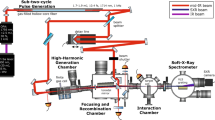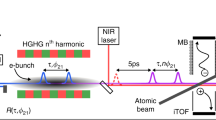Abstract
In Bohr's model of the hydrogen atom, the electron takes about 150 attoseconds (1 as = 10-18 s) to orbit around the proton, defining the characteristic timescale for dynamics in the electronic shell of atoms. Recording atomic transients in real time requires excitation and probing on this scale. The recent observation of single sub-femtosecond (1 fs = 10-15 s) extreme ultraviolet (XUV) light pulses1 has stimulated the extension of techniques of femtochemistry2 into the attosecond regime3,4. Here we demonstrate the generation and measurement of single 250-attosecond XUV pulses. We use these pulses to excite atoms, which in turn emit electrons. An intense, waveform-controlled, few cycle laser pulse5 obtains ‘tomographic images’ of the time-momentum distribution of the ejected electrons. Tomographic images of primary (photo)electrons yield accurate information of the duration and frequency sweep of the excitation pulse, whereas the same measurements on secondary (Auger) electrons will provide insight into the relaxation dynamics of the electronic shell following excitation. With the current ∼750-nm laser probe and ∼100-eV excitation, our transient recorder is capable of resolving atomic electron dynamics within the Bohr orbit time.
This is a preview of subscription content, access via your institution
Access options
Subscribe to this journal
Receive 51 print issues and online access
$199.00 per year
only $3.90 per issue
Buy this article
- Purchase on Springer Link
- Instant access to full article PDF
Prices may be subject to local taxes which are calculated during checkout





Similar content being viewed by others
References
Hentschel, M. et al. Attosecond metrology. Nature 414, 509–513 (2001)
Zewail, A. Femtochemistry: atomic-scale dynamics of the chemical bond (adapted from the Nobel Lecture). J. Phys. Chem. A 104, 5660–5694 (2000)
Itatani, J. et al. Attosecond streak camera. Phys. Rev. Lett. 88, 173903 (2002)
Kitzler, M., Milosevic, N., Scrinzi, A., Krausz, F. & Brabec, T. Quantum theory of attosecond XUV pulse measurement by laser-dressed photoionization. Phys. Rev. Lett. 88, 173904 (2002)
Baltuska, A. et al. Attosecond control of electronic processes by intense light fields. Nature 421, 611–615 (2003)
Bradley, D. J., Liddy, B. & Sleat, W. E. Direct linear measurement of ultrashort light pulses with a picosecond streak camera. Opt. Commun. 2, 391 (1971)
Schelev, M. Ya., Richardson, M. C. & Alcock, A. J. Image-converter streak camera with picosecond resolution. Appl. Phys. Lett. 18, 354 (1971)
Kane, D. J. & Trebino, R. Characterization of arbitrary femtosecond pulses using frequency-resolved optical gating. IEEE J. Quantum Electron. 29, 571–579 (1993)
Sekikawa, T., Katsura, T., Miura, S. & Watanabe, S. Measurement of the intensity-dependent atomic dipole phase of a high harmonic by frequency-resolved optical gating. Phys. Rev. Lett. 88, 193902 (2002)
L'Huillier, A. & Balcou, Ph. High-order harmonic generation in rare gases with a 1-ps 1053-nm laser. Phys. Rev. Lett. 70, 774–777 (1993)
Macklin, J. J., Kmetec, J. D. & Gordon, C. L. III High-order harmonic generation using intense femtosecond pulses. Phys. Rev. Lett. 70, 766–769 (1993)
Schafer, K. J., Yang, B., DiMauro, L. F. & Kulander, K. C. Above threshold ionization beyond the high harmonic cutoff. Phys. Rev. Lett. 70, 1599–1602 (1993)
Corkum, P. B. Plasma perspective on strong-field multiphoton ionization. Phys. Rev. Lett. 71, 1994–1997 (1993)
Lewenstein, M., Balcou, Ph., Ivanov, M. Yu., L'Huillier, A. & Corkum, P. B. Theory of high-harmonic generation by low-frequency laser fields. Phys. Rev. A 49, 2117–2132 (1994)
Christov, I. P., Murnane, M. M. & Kapteyn, H. C. High-harmonic generation of attosecond pulses in the “single-cycle” regime. Phys. Rev. Lett. 78, 1251–1254 (1997)
Kan, C., Burnett, N. H., Capjack, C. E. & Rankin, R. Coherent XUV generation from gases ionized by several cycle optical pulses. Phys. Rev. Lett. 79, 2971–2974 (1997)
de Bohan, A., Antoine, P., Milosevic, D. B. & Piraux, B. Phase-dependent harmonic emission with ultrashort laser pulses. Phys. Rev. Lett. 81, 1837–1840 (1998)
Tempea, G., Geissler, M. & Brabec, T. Phase sensitivity of high-order harmonic generation with few-cycle laser pulses. J. Opt. Soc. Am. B 16, 669–674 (1999)
Paul, P. M. et al. Observation of a train of attosecond pulses from high harmonic generation. Science 292, 1689–1692 (2001)
Mairesse, Y. et al. Attosecond synchronisation of high-harmonic soft X-rays. Science 302, 1540–1543 (2003)
Tzallas, P., Charalambidis, D., Papadogiannis, N. A., Witte, K. & Tsakiris, G. D. Direct observation of attosecond light bunching. Nature 426, 267–271 (2003)
Drescher, M. et al. Time-resolved atomic inner-shell spectroscopy. Nature 419, 803–807 (2002)
Acknowledgements
This work was sponsored by the Fonds zur Förderung der wissenschaftlichen Forschung (Austria), the Deutsche Forschungsgemeinschaft and the Volkswagenstiftung (Germany) and by the European Union's Human Potential Programme.
Author information
Authors and Affiliations
Corresponding author
Ethics declarations
Competing interests
The authors declare that they have no competing financial interests.
Rights and permissions
About this article
Cite this article
Kienberger, R., Goulielmakis, E., Uiberacker, M. et al. Atomic transient recorder. Nature 427, 817–821 (2004). https://doi.org/10.1038/nature02277
Received:
Accepted:
Issue Date:
DOI: https://doi.org/10.1038/nature02277
This article is cited by
-
Spatiotemporal imaging and shaping of electron wave functions using novel attoclock interferometry
Nature Communications (2024)
-
Sub-cycle multidimensional spectroscopy of strongly correlated materials
Nature Photonics (2024)
-
Ionization of hydrogen atom driven by ultrashort intense laser pulses: study in momentum space of phase-dependent effects
Indian Journal of Physics (2024)
-
Quench dynamics of Fano-like resonances in the presence of the on-dot superconducting pairing
Scientific Reports (2023)
-
High-order harmonic generation from Rydberg atoms by using three-color laser pulse
Journal of Optics (2023)
Comments
By submitting a comment you agree to abide by our Terms and Community Guidelines. If you find something abusive or that does not comply with our terms or guidelines please flag it as inappropriate.



